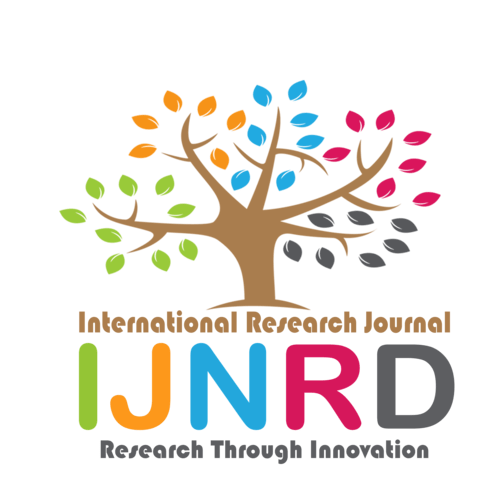|
|||||||||||||||

|
INTERNATIONAL JOURNAL OF NOVEL RESEARCH AND DEVELOPMENT International Peer Reviewed & Refereed Journals, Open Access Journal ISSN Approved Journal No: 2456-4184 | Impact factor: 8.76 | ESTD Year: 2016 Scholarly open access journals, Peer-reviewed, and Refereed Journals, Impact factor 8.76 (Calculate by google scholar and Semantic Scholar | AI-Powered Research Tool) , Multidisciplinary, Monthly, Indexing in all major database & Metadata, Citation Generator, Digital Object Identifier(DOI) |
||||||||||||||
Issue: April 2024
Volume 9 | Issue 4
Review Result and Publication of Paper within : 2-3 days
Click Here For more DetailsFor Authors
Forms / Download
Published Issue Details
Editorial Board
Other IMP Links
Facts & Figure
Impact Factor : 8.76
Issue per Year : 12
Volume Published : 9
Issue Published : 95
Article Submitted :
Article Published :
Total Authors :
Total Reviewer :
Total Countries :
Indexing Partner
Join RMS/Earn 300
Licence
This work is licensed under a Creative Commons Attribution-NonCommercial 4.0 International License







|
Published Paper Details
|
|
| Paper Title: | Desertification- An Ecological Cataclysm |
| Authors Name: | Dr. Charlotte Braganza |
| Download E-Certificate: | Download |
| Author Reg. ID: |
IJNRD_180872
|
| Published Paper Id: | IJNRD2204077 |
| Published In: | Volume 7 Issue 4, April-2022 |
| DOI: | |
| Abstract: | Deserts are amid "fragile ecosystems". Desertification includes land degradation in arid, semi-arid and dry sub humid areas resulting from various factors, including climatic variations and anthropogenic happenings. The trend is more likely to become irreversible if the environment becomes drier with prolonged droughts, and the soil becomes further degraded through erosion and compaction. Drought drains a land of its life-supporting capabilities and declining groundwater tables, increasing erosion, and the disappearance of native vegetation characterise the process. Desertification has affected as much as one-sixth of the world's population, seventy percent of all drylands, and one-quarter of the total land area of the world. This has resulted in widespread poverty as well as in the degradation of billion hectares of rangeland and cropland. Desertification became well known in the 1930's, when parts of the Great Plains in the United States turned into the "Dust Bowl" as a result of drought and poor practices in farming, although the term itself was not used until almost 1950. During the dust bowl period, millions of people were forced to abandon their farms and livelihoods. Greatly improved methods of agriculture and land and water management in the Great Plains have prevented that disaster from recurring, but desertification presently affects millions of people in almost every continent. The present paper is an introspection unfolding the impact of desertification in various deserts of the world and remedial measures for repairment. |
| Keywords: | Land Degradation, arid, semiarid, ,anthropogenic |
| Cite Article: | "Desertification- An Ecological Cataclysm", International Journal of Novel Research and Development (www.ijnrd.org), ISSN:2456-4184, Vol.7, Issue 4, page no.662-666, April-2022, Available :http://www.ijnrd.org/papers/IJNRD2204077.pdf |
| Downloads: | 000118758 |
| ISSN: |
2456-4184 | IMPACT FACTOR: 8.76 Calculated By Google Scholar| ESTD YEAR: 2016 An International Scholarly Open Access Journal, Peer-Reviewed, Refereed Journal Impact Factor 8.76 Calculate by Google Scholar and Semantic Scholar | AI-Powered Research Tool, Multidisciplinary, Monthly, Multilanguage Journal Indexing in All Major Database & Metadata, Citation Generator |
| Publication Details: |
Published Paper ID:IJNRD2204077 Registration ID: 180872 Published In: Volume 7 Issue 4, April-2022 DOI (Digital Object Identifier): Page No: 662-666 Country: Mumbai, Maharashtra, India Research Area: Engineering Publisher : IJ Publication Published Paper URL : https://www.ijnrd.org/viewpaperforall?paper=IJNRD2204077 Published Paper PDF: https://www.ijnrd.org/papers/IJNRD2204077 |
| Share Article: | |
|
Click Here to Download This Article |
|
| Article Preview | |
|
|
|
Major Indexing from www.ijnrd.org
| Semantic Scholar | Microsaoft Academic | ORCID | Zenodo |
| Google Scholar | ResearcherID Thomson Reuters | Mendeley : reference manager | Academia.edu |
| arXiv.org : cornell university library | Research Gate | CiteSeerX | PUBLON |
| DRJI | SSRN | Scribd | DocStoc |
ISSN Details
 |
 |
ISSN: 2456-4184
Impact Factor: 8.76 and ISSN APPROVED
Journal Starting Year (ESTD) : 2016
DOI (A digital object identifier)
Conference
Open Access License Policy
Important Details
Social Media
| Copyright © 2024 - All Rights Reserved - IJNRD |












Facebook Twitter Instagram LinkedIn